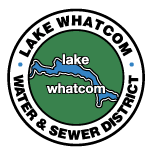How Rates Are Set
Many District customers, especially those who have just moved to the area, have questions about what makes up the cost of their bi-monthly bill. Below is some basic information about factors that influence the rates in our unique District.
Billing is Bi-monthly
The District’s utility bills are for services received in the previous two months and are mailed out bi-monthly (every two months). Sewer is billed at a flat rate. All water service is metered. Water use from 0-600 cubic feet per billing period is included in the base charge. The monthly rate for water and sewer is equal to half of the base charges for one billing cycle.
Click here for more information on Rates & Billing Dates
Click here for more information on Meters and Metering
All Customers Pay a Base Rate
The District is sometimes asked about the reason all customers pay the same base rate, regardless of usage. Nearly all water utilities have a “base charge”—a fixed charge per billing period for a given customer. Lake Whatcom Water & Sewer District is a special purpose district, which is different than a utility run by a city or state. Our operations are entirely rate-payer supported. Because of this, a base charge ensures revenue stability, since much of the cost of maintaining water treatment plants, pump stations, reservoirs, and over 70 miles of pipe consists of fixed costs that do not vary with consumption.
Since 2003, the District has had a usage allowance of 600 cubic feet per billing period. In setting the base allowance, our Board of Commissioners must strike a balance between supporting operations and serving different household sizes with different base volumes of usage. Including an allowance in the base rate strengthens revenue stability beyond what would come from a base charge alone. Eliminating the usage allowance and charging customers for all usage would result in potentially higher and less consistent bills. Allowing a larger allowance would require a higher base rate, which would penalize smaller families and conservative households. The District’s threshold of 600 cubic feet per bimonthly period is about 65% of the average usage.
Our District is Small & Unique
If you are a Lake Whatcom Water and Sewer District customer, you are living in an environmentally sensitive and difficult to serve area. The District has a relatively small, mostly residential customer base; currently about 4,000 customers. Our rates are based on cost of service. Other than the occasional grant or low-interest loan for specific infrastructure projects, the District receives no outside funding. All costs are borne by our customers.
The mostly forested, steep slopes of the District’s service area require extensive infrastructure. The bowl-shaped topography of our service area means more pumps are required, both to deliver water to our customers’ homes and for pumping and transporting sewage out of the watershed. The District owns, maintains, and operates 28 sewer pump stations, more than are necessary for the entire City of Bellingham.
Sewage Treatment Must be Outsourced
The entirety of the Lake Whatcom Water and Sewer District is located within the boundaries of the Lake Whatcom Watershed. Serving customers in the watershed presents some unique challenges to the District, including the inability to treat or process our customer’s sewage. All wastewater must be transported to the City of Bellingham’s wastewater treatment plant located at Post Point in the Fairhaven area.
In addition to the infrastructure required, District customers must also pay their fair share of the City of Bellingham’s costs for processing their sewage. The City of Bellingham’s sewage treatment bill accounts for roughly 1/4 of the District’s annual operating budget. Sewer disposal costs and a share of the City’s facility upgrades and maintenance costs to the District are based upon the volume of sewage that is sent to the wastewater treatment plant.
Improvements, Maintenance, and Infrastructure are Part of Your Rates
Much of the District’s sewer system was originally installed in the early to mid-1970s. Infrastructure such as pump stations and transmission lines wear out over time and must be refurbished, repaired, or replaced as needed. Engineers estimate that sewer pump stations have an effective life of around 30 years.
The District also owns, operates, and maintains over 71 miles of water transmission and distribution lines, and over 75 miles of sewage collection and conveyance lines. Depending upon different factors such as the types of material that the pipes are made of, engineers estimate that sewer transmission lines have an effective life of roughly 100 years. Transmission lines are also vulnerable to breakage and plugging from causes other than normal wear and tear.
Covering Today, Preparing for Tomorrow
The Board must think ahead and be prepared for upgrades, repairs, replacements, and emergencies.
Setting utility rates is a complex issue. In setting the rates, the District’s Board of Commissioners must ensure money is budgeted to pay for the day to day operations of the District, as well as to cover future infrastructure upgrades, repairs, and replacements. Because rate setting is such a complex issue, the District has periodic rate studies performed by a professional rate consultant.
The District’s Commissioners have established a rate schedule that typically increases annually to accommodate projected capital improvement and operating costs into the future. Revenues and expenditures are forecast utilizing the following key assumptions:
- General inflation is estimated at 2.5% per year.
- Labor Cost inflation is estimated at 2.5% per year.
- Employee benefit cost inflation is estimated at 5% per year.
- General construction costs are inflated at 3% per year.
A system replacement (depreciation) funding policy is currently in place to fund annually from rates an amount equal to annual depreciation expenses.
Please visit our billing rates page for more information about current rates.
